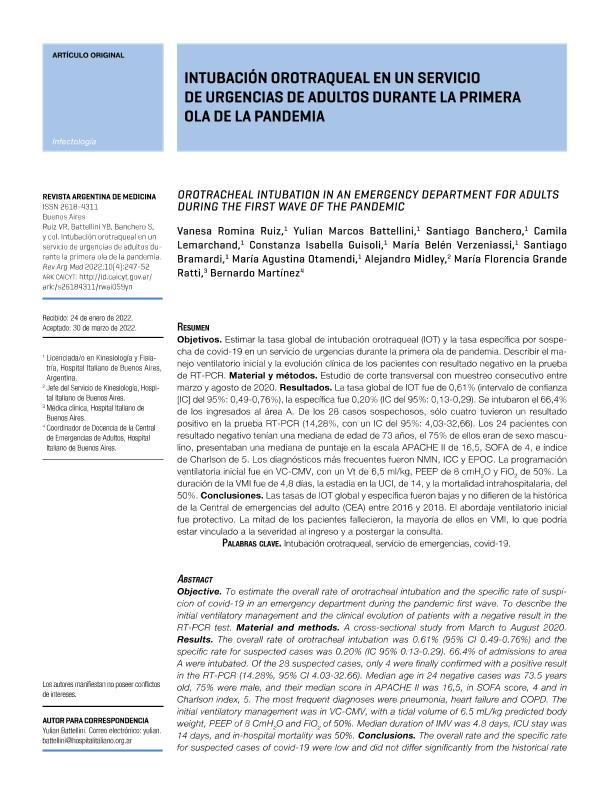Artículo
Objetivos. Estimar la tasa global de intubación orotraqueal (IOT) y la tasa específica por sospecha de covid-19 en un servicio de urgencias durante la primera ola de pandemia. Describir el manejo ventilatorio inicial y la evolución clínica de los pacientes con resultado negativo en la prueba de RT-PCR. Material y métodos. Estudio de corte transversal con muestreo consecutivo entre marzo y agosto de 2020. Resultados. La tasa global de IOT fue de 0,61% (intervalo de confianza [IC] del 95%: 0,49-0,76%), la específica fue 0,20% (IC del 95%: 0,13-0,29). Se intubaron el 66,4% de los ingresados al área A. De los 28 casos sospechosos, sólo cuatro tuvieron un resultado positivo en la prueba RT-PCR (14,28%, con un IC del 95%: 4,03-32,66). Los 24 pacientes con resultado negativo tenían una mediana de edad de 73 años, el 75% de ellos eran de sexo masculino, presentaban una mediana de puntaje en la escala APACHE II de 16,5, SOFA de 4, e índice de Charlson de 5. Los diagnósticos más frecuentes fueron NMN, ICC y EPOC. La programación ventilatoria inicial fue en VC-CMV, con un Vt de 6,5 ml/kg, PEEP de 8 cmH2O y FiO2 de 50%. La duración de la VMI fue de 4,8 días, la estadía en la UCI, de 14, y la mortalidad intrahospitalaria, del 50%. Conclusiones. Las tasas de IOT global y específica fueron bajas y no difieren de la histórica de la Central de emergencias del adulto (CEA) entre 2016 y 2018. El abordaje ventilatorio inicial fue protectivo. La mitad de los pacientes fallecieron, la mayoría de ellos en VMI, lo que podría estar vinculado a la severidad al ingreso y a postergar la consulta. Objective. To estimate the overall rate of orotracheal intubation and the specific rate of suspicion of covid-19 in an emergency department during the pandemic first wave. To describe the initial ventilatory management and the clinical evolution of patients with a negative result in the RT-PCR test. Material and methods. A cross-sectional study from March to August 2020. Results. The overall rate of orotracheal intubation was 0.61% (95% CI 0.49-0.76%) and the specific rate for suspected cases was 0.20% (IC 95% 0.13-0.29). 66.4% of admissions to area A were intubated. Of the 28 suspected cases, only 4 were finally confirmed with a positive result in the RT-PCR (14.28%, 95% CI 4.03-32.66). Median age in 24 negative cases was 73.5 years old, 75% were male, and their median score in APACHE II was 16,5, in SOFA score, 4 and in Charlson index, 5. The most frequent diagnoses were pneumonia, heart failure and COPD. The initial ventilatory management was in VC-CMV, with a tidal volume of 6.5 mL/kg predicted body weight, PEEP of 8 CmH2O and FiO2 of 50%. Median duration of IMV was 4.8 days, ICU stay was 14 days, and in-hospital mortality was 50%. Conclusions. The overall rate and the specific rate for suspected cases of covid-19 were low and did not differ significantly from the historical rate of the Adult emergency department (CEA, its acronym in Spanish) between 2016 and 2018. The initial ventilatory management was protective. Half of the patients died, most of them without being weaned from mechanical ventilation. This could be related to the severity scored at admission and delay in medical consultation.
Intubación orotraqueal en un servicio de urgencias de adultos durante la primera ola de la pandemia
Título:
Orotracheal intubation in an emergency department for adults during the first wave of the pandemic
Ruiz, Vanesa Romina; Battellini, Yulian Marcos; Banchero, Santiago; Lemarchand, Camila; Guisoli, Constanza Isabella; Verzeniassi, María Belén; Bramardi, Santiago; Otamendi, María Agustina; Midley, Alejandro; Grande Ratti, Maria Florencia ; Martínez, Bernardo
; Martínez, Bernardo
 ; Martínez, Bernardo
; Martínez, Bernardo
Fecha de publicación:
01/2023
Editorial:
Sociedad Argentina de Medicina
Revista:
Revista Argentina de Medicina
ISSN:
2618-4311
Idioma:
Español
Tipo de recurso:
Artículo publicado
Clasificación temática:
Resumen
Palabras clave:
COVID-19
,
SERVICIO DE EMERGENCIAS
,
INTUBACIÓN OROTRAQUEAL
Archivos asociados
Licencia
Identificadores
Colecciones
Articulos(SEDE CENTRAL)
Articulos de SEDE CENTRAL
Articulos de SEDE CENTRAL
Citación
Ruiz, Vanesa Romina; Battellini, Yulian Marcos; Banchero, Santiago; Lemarchand, Camila; Guisoli, Constanza Isabella; et al.; Intubación orotraqueal en un servicio de urgencias de adultos durante la primera ola de la pandemia; Sociedad Argentina de Medicina; Revista Argentina de Medicina; 10; 4; 1-2023; 247-252
Compartir



